Effect of Temporal Sampling Interval on the Irradiance for Moon-Based Wide Field-of-View Radiometer
Abstract
:1. Introduction
2. Materials and Methods
2.1. Moon-Based Earth Observation Geometry
2.2. Radiation Transfer Function
2.3. ADMs and Datasets
2.4. The Simulated Original Irradiance Time Series
2.5. Methodology
2.5.1. Temporal Sampling Method and Metrics
2.5.2. Discrete Fast Fourier Transforms (FFT)
3. Results
3.1. The Original Time Series
3.2. Temporal Sampling Uncertainties
3.3. The Effect of Sampling Intervals and Sampling Time
3.4. The Effect of Sampling Intervals on Coverage Ability
3.5. Frequency Analysis of Irradiance
4. Discussion
5. Conclusions
Author Contributions
Funding
Institutional Review Board Statement
Informed Consent Statement
Data Availability Statement
Acknowledgments
Conflicts of Interest
References
- Dewitte, S. Editorial for Special Issue “Earth Radiation Budget”. Remote Sens. 2020, 12, 3379. [Google Scholar] [CrossRef]
- Dewitte, S.; Clerbaux, N. Measurement of the Earth radiation budget at the top of the atmosphere—A review. Remote Sens. 2017, 9, 1143. [Google Scholar] [CrossRef] [Green Version]
- Barkstrom, B.R.; Smith, G.L. The Earth Radiation Budget Experiment: Science and implementation. Rev. Geophys. 1984, 24, 379–390. [Google Scholar] [CrossRef]
- Luther, M.R.; Cooper, J.E.; Taylor, G.R. The Earth Radiation Budget Experiment Nonscanner Instrument. Rev. Geophys. 1986, 24, 391–399. [Google Scholar] [CrossRef]
- Kopia, L.P. Earth Radiation Budget Experiment Scanner Instrument. Rev. Geophys. 1986, 24, 400–406. [Google Scholar] [CrossRef]
- Wielicki, B.A.; Barkstrom, B.R.; Harrison, E.F.; Lee, R.B., III; Smith, G.L.; Cooper, J.E. Clouds and the Earth’s Radiant Energy System (CERES): An earth observing system experiment. Bull. Am. Meteorol. Soc. 1996, 77, 853–868. [Google Scholar] [CrossRef] [Green Version]
- Loeb, N.G.; Manalo-Smith, N.; Su, W.; Shankar, M.; Thomas, S. CERES top-of-atmosphere Earth radiation budget climate data record: Accounting for in-orbit changes in instrument calibration. Remote Sens. 2016, 8, 182. [Google Scholar] [CrossRef] [Green Version]
- Clerbaux, N.; Dewitte, S.; Bertrand, C.; Caprion, D.; De Paepe, B.; Gonzalez, L.; Ipe, A.; Russell, J.E.; Brindley, H. Unfiltering of the geostationary earth radiation budget (GERB) data. Part I: Shortwave radiation. J. Atmos. Ocean. Technol. 2008, 25, 1087–1105. [Google Scholar] [CrossRef]
- Clerbaux, N.; Dewitte, S.; Bertrand, C.; Caprion, D.; De Paepe, B.; Gonzalez, L.; Ipe, A.; Russell, J.E. Unfiltering of the geostationary earth radiation budget (GERB) data. Part II: Longwave radiation. J. Atmos. Ocean. Technol. 2008, 25, 1106–1117. [Google Scholar] [CrossRef] [Green Version]
- Clerbaux, N.; Russell, J.E.; Dewitte, S.; Bertrand, C.; Caprion, D.; De Paepe, B.; Gonzalez, L.; Ipe, A.; Bantges, R.; Brindley, H.E. Comparison of GERB instantaneous radiance and flux products with CERES Edition-2 data. Remote Sens. Environ. 2009, 113, 102–114. [Google Scholar] [CrossRef]
- Su, W.; Minnis, P.; Liang, L.; Duda, D.P.; Khlopenkov, K.; Thieman, M.M.; Yu, Y.; Smith, A.; Lorentz, S.; Feldman, D.; et al. Determining the daytime Earth radiative flux from National Institute of Standards and Technology Advanced Radiometer (NISTAR) measurements. Atmos. Meas. Tech. 2020, 13, 429–443. [Google Scholar] [CrossRef] [Green Version]
- Huang, S.; Zhu, P.; Ye, X.; Li, Q.; Shu, L.; Liu, Y.; Fang, W. The Idea of Moon-based Earth Radiation Budget Experiment (MERBE). In Proceedings of the 43rd COSPAR Scientific Assembly, Online, 28 January–4 February 2021; Volume 43, p. 369. [Google Scholar]
- Ye, H.; Guo, H.; Liu, G.; Ping, J.; Zhang, L.; Zhang, Y. Estimating the Earth’s Outgoing Longwave Radiation Measured from a Moon-Based Platform. Remote Sens. 2021, 13, 2201. [Google Scholar] [CrossRef]
- Guo, H.; Liu, G.; Ding, Y. Moon-based Earth observation: Scientific concept and potential applications. Int. J. Digit. Earth 2018, 11, 546–557. [Google Scholar] [CrossRef]
- Ye, H.; Guo, H.; Liu, G.; Ren, Y. Observation duration analysis for Earth surface features from a Moon-based platform. Adv. Space Res. 2018, 62, 274–287. [Google Scholar] [CrossRef]
- Pallé, E.; Goode, P.R. The Lunar Terrestrial Observatory: Observing the Earth using photometers on the Moon’s surface. Adv. Space Res. 2009, 43, 1083–1089. [Google Scholar] [CrossRef]
- Wang, H.; Guo, Q.; Li, A.; Liu, G.; Guo, H.; Huang, J. Comparative study on the observation duration of the two-polar regions of the Earth from four specific sites on the Moon. Int. J. Remote Sens. 2020, 41, 339–352. [Google Scholar] [CrossRef]
- Song, Y.; Wang, X.; Bi, S.; Wu, J.; Huang, S. Effects of solar radiation, terrestrial radiation and lunar interior heat flow on surface temperature at the nearside of the Moon: Based on numerical calculation and data analysis. Adv. Space Res. 2017, 60, 938–947. [Google Scholar] [CrossRef]
- Lohmeyer, W.Q.; Cahoy, K. Space weather radiation effects on geostationary satellite solid-state power amplifiers. Space Weather 2013, 11, 476–488. [Google Scholar] [CrossRef] [Green Version]
- Durante, M.; Cucinotta, F.A. Physical basis of radiation protection in space travel. Rev. Mod. Phys. 2011, 83, 1245. [Google Scholar] [CrossRef]
- Johnson, J.R.; Lucey, P.G.; Stone, T.C.; Staid, M.I. Visible/Near-Infrared Remote Sensing of Earth from the Moon; Associated with the Lunar Exploration Architecture White Papers. In Proceedings of the NASA Advisory Council Workshop on Science, Tempe, AZ, USA, 27 February–2 March 2007. [Google Scholar]
- Sui, Y.; Guo, H.; Liu, G.; Ren, Y. Analysis of Long-Term Moon-Based Observation Characteristics for Arctic and Antarctic. Remote Sens. 2019, 11, 2805. [Google Scholar] [CrossRef] [Green Version]
- Yuan, L.; Liao, J. A physical-based algorithm for retrieving land surface temperature from Moon-based Earth observation. IEEE J. Sel. Top. Appl. Earth Obs. Remote Sens. 2020, 13, 1856–1866. [Google Scholar] [CrossRef]
- Yuan, L.; Liao, J. Exploring the influence of various factors on microwave radiation image simulation for Moon-based Earth observation. Front. Earth Sci. 2019, 14, 430–445. [Google Scholar] [CrossRef]
- Huang, S. Surface temperatures at the nearside of the Moon as a record of the radiation budget of Earth’s climate system. Adv. Space Res. 2008, 41, 1853–1860. [Google Scholar] [CrossRef]
- Guo, H.D.; Liu, G.; Ding, Y.X.; Zou, Y.L.; Huang, S.P.; Jiang, L.M.; Jia, G.S.; Lv, M.Y.; Ren, Y.Z.; Ruan, Z.X.; et al. Moon-Based Earth Observation for Large Scale Geoscience Phenomena. In Proceedings of the International Geoscience and Remote Sensing Symposium, Beijing, China, 10–15 July 2016; pp. 3705–3707. [Google Scholar]
- Duan, W.; Huang, S.; Nie, C. Entrance pupil irradiance estimating model for a moon-based Earth radiation observatory instrument. Remote Sens. 2019, 11, 583. [Google Scholar] [CrossRef] [Green Version]
- Ye, H.; Guo, H.; Liu, G.; Guo, Q.; Zhang, L.; Huang, J. Temporal sampling error analysis of the Earth’s outgoing radiation from a Moon-based platform. Int. J. Remote Sens. 2019, 40, 6975–6992. [Google Scholar] [CrossRef]
- Jacobowitz, H.; Soule, H.V.; Kyle, H.L.; House, F.B. The earth radiation budget (ERB) experiment: An overview. J. Geophys. Res. Atmos. 1984, 89, 5021–5038. [Google Scholar] [CrossRef]
- Qiu, H.; Hu, L.; Zhang, Y.; Lu, D.; Qi, J. Absolute Radiometric Calibration of Earth Radiation Measurement on FY-3B and Its Comparison with CERES/Aqua Data. IEEE Trans. Geosci. Remote Sens. 2012, 50, 4965–4974. [Google Scholar] [CrossRef]
- Sklyarov, Y.; Brichkov, Y.; Vorobyov, V.; Kotuma, A.; Fomina, N. Radiometric measurements from Russian satellites Meteor-3 7 and Resurs-1. Mapp. Sci. Remote Sens. 2000, 37, 73–75. [Google Scholar]
- Swartz, W.H.; Lorentz, S.R.; Papadakis, S.J.; Huang, P.M.; Smith, A.W.; Deglau, D.M.; Yu, Y.; Reilly, S.M.; Reilly, N.M.; Anderson, D.E. RAVAN: CubeSat demonstration for multi-point Earth radiation budget measurements. Remote Sens. 2019, 11, 796. [Google Scholar] [CrossRef] [Green Version]
- Swartz, B.H.; Dyrud, L.P.; Lorentz, S.R.; Wu, D.G.; Wiscombe, W.J.; Papadakis, S.J. The RAVAN CubeSat mission: Progress toward a new measurement of Earth outgoing radiation. In AGU Fall Meeting Abstracts, Proceedings of the AGU Fall Meeting, San Francisco, CA, USA, 15–19 December 2014; American Geographical Union: Washington, DC, USA, 2014; p. A22F-04. [Google Scholar]
- Schifano, L.; Smeesters, L.; Geernaert, T.; Berghmans, F.; Dewitte, S. Design and analysis of a next-generation wide field-of-view Earth radiation budget radiometer. Remote Sens. 2020, 12, 425. [Google Scholar] [CrossRef] [Green Version]
- Holman, J.P. Heat Transfer, 9th ed.; McGraw—Hill: New York, NY, USA, 2002; Volume 7. [Google Scholar]
- Yang, S.; Tao, W. Numerical Heat Transfer, 4th ed.; Higher Education Press: Beijing, China, 2006; pp. 350–439. (In Chinese) [Google Scholar]
- Loeb, N.G.; Manalo-Smith, N.; Kato, S.; Miller, W.F.; Gupta, S.K.; Minnis, P.; Wielicki, B.A. Angular distribution models for top-of-atmosphere radiative flux estimation from the Clouds and the Earth’s Radiant Energy System instrument on the Tropical Rainfall Measuring Mission satellite. Part I: Methodology. J. Appl. Meteorol. 2003, 42, 240–265. [Google Scholar] [CrossRef]
- Su, W.; Corbett, J.; Eitzen, Z.; Liang, L. Next-generation angular distribution models for top-of-atmosphere radiative flux calculation from CERES instruments: Methodology. Atmos. Meas. Tech. 2015, 8, 611–632. [Google Scholar] [CrossRef] [Green Version]
- Su, W.; Corbett, J.; Eitzen, Z.; Liang, L. Next-generation angular distribution models for top-of-atmosphere radiative flux calculation from CERES instruments: Validation. Atmos. Meas. Tech. 2015, 8, 3297–3313. [Google Scholar] [CrossRef] [Green Version]
- Smith, G.L.; Green, R.N.; Raschke, E.; Avis, L.M.; Suttles, J.T.; Wielicki, B.A.; Davies, R. Inversion methods for satellite studies of the Earth’s radiation budget: Development of algorithms for the ERBE mission. Rev. Geophys. 1986, 24, 407–421. [Google Scholar] [CrossRef]
- Suttles, J.T.; Green, R.N.; Minnis, P.; Smith, G.; Staylor, W.; Wielicki, B.; Walker, I.J.; Young, D.F.; Taylor, V.R.; Stowe, L. Shortwave Radiation. Angular Radiation Models for Earth-Atmosphere System; National Aeronautics and Space Administration: Washington, DC, USA, 1988; Volume 1.
- Suttles, J.T.; Green, R.N.; Smith, G.L.; Wielicki, B.A.; Walker, I.J.; Taylor, V.R.; Stowe, L.L. Longwave Radiation. Angular Radiation Models for Earth-Atmosphere System; National Aeronautics and Space Administration: Washington, DC, USA, 1989; Volume 2.
- Rutan, D.A.; Kato, S.; Doelling, D.R.; Rose, F.G.; Nguyen, L.T.; Caldwell, T.E.; Loeb, N.G. CERES synoptic product: Methodology and validation of surface radiant flux. J. Atmos. Ocean. Technol. 2015, 32, 1121–1143. [Google Scholar] [CrossRef]
- NASA; LARC; SD; ASDC. CERES and GEO-Enhanced TOA, Within-Atmosphere and Surface Fluxes, Clouds and Aerosols 1-Hourly Terra-Aqua Edition 4A. 2017. Available online: https://asdc.larc.nasa.gov/project/CERES/CER_SYN1deg-1Hour_Terra-Aqua-MODIS_Edition4A (accessed on 3 May 2021).
- Smith, G.L.; Priestley, K.J.; Loeb, N.G.; Wielicki, B. Clouds and Earth Radiant Energy System (CERES), a review: Past, present and future. Adv. Space Res. 2011, 48, 254–263. [Google Scholar] [CrossRef]
- Holdaway, D.; Yang, Y. Study of the effect of temporal sampling frequency on DSCOVR observations using the GEOS-5 nature run results (part I): Earth’s radiation budget. Remote Sens. 2016, 8, 98. [Google Scholar] [CrossRef] [Green Version]
- Holdaway, D.; Yang, Y. Study of the effect of temporal sampling frequency on DSCOVR observations using the GEOS-5 nature run results (part II): Cloud coverage. Remote Sens. 2016, 8, 431. [Google Scholar] [CrossRef] [Green Version]
- Ye, H.; Zheng, W.; Guo, H.; Liu, G. Effects of Ellipsoidal Earth Model on Estimating the Sensitivity of Moon-Based Outgoing Longwave Radiation Measurements. IEEE Geosci. Remote Sens. Lett. 2021, 19, 1–5. [Google Scholar] [CrossRef]
- Feldman, D.R.; Su, W.; Minnis, P. Subdiurnal to Interannual Frequency Analysis of Observed and Modeled Reflected Shortwave Radiation From Earth. Geophys. Res. Lett. 2021, 48, e2020GL089221. [Google Scholar] [CrossRef]
- Frigo, M.; Johnson, S.G. FFTW: An Adaptive Software Architecture for the FFT. In Proceedings of the 1998 IEEE International Conference on Acoustics, Speech and Signal Processing, ICASSP’98, Seattle, WA, USA, 12–15 May 1998; Volume 3, pp. 1381–1384. [Google Scholar]
- Qian, Y.; Wan, H.; Yang, B.; Golaz, K.-C.; Harrop, B.; Hou, Z.; Larson, V.E.; Leung, L.R.; Lin, G.; Lin, W.; et al. Parametric sensitivity and uncertainty quantification in the version 1 of E3SM atmosphere model based on short perturbed parameter ensemble simulations. J. Geophys. Res. Atmos. 2018, 123, 13. [Google Scholar] [CrossRef] [Green Version]
- Rogalski, A. Infrared Detectors; Novel Thermal Detectors; CRC Press: Boca Raton, FL, USA, 2010; pp. 179–196. [Google Scholar]
- Dewitte, S.; Karatekin, Ö.; Chevalier, A.; Clerbaux, N.; Meftah, M.; Irbah, A.; Delabie, T. The sun-earth imbalance radiometer for a direct measurement of the net heating of the earth. In EGU General Assembly Conference Abstracts, Proceedings of the European Geosciences Union General Assembly, Vienna, Austria, 12–17 April 2015; European Geosciences Union: Munich, Germany, 2015; p. 15259. [Google Scholar]
- Barnes, R.A.; Eplee, R.E., Jr.; Patt, F.S. SeaWiFS Measurements of the Moon. In Sensors, Systems, and Next-Generation Satellites II; International Society for Optics and Photonics: Bellingham, WA, USA, 1998; Volume 3498, pp. 311–324. [Google Scholar]
- Sun, J.Q.; Xiong, X.; Barnes, W.L.; Guenther, B. MODIS reflective solar bands on-orbit lunar calibration. IEEE Trans. Geosci. Remote Sens. 2007, 45, 2383–2393. [Google Scholar] [CrossRef]
- Li, C.; Wang, C.; Wei, Y.; Lin, Y. China’s present and future lunar exploration program. Science 2019, 365, 238–239. [Google Scholar] [CrossRef] [PubMed]
- Gerstenmaier, W. Progress in Defining the Deep Space Gateway and Transport Plan. In Proceedings of the NASA Advisory Council Human Exploration and Operations Committee Meeting, Washington, DC, USA, 28–29 March 2017. [Google Scholar]






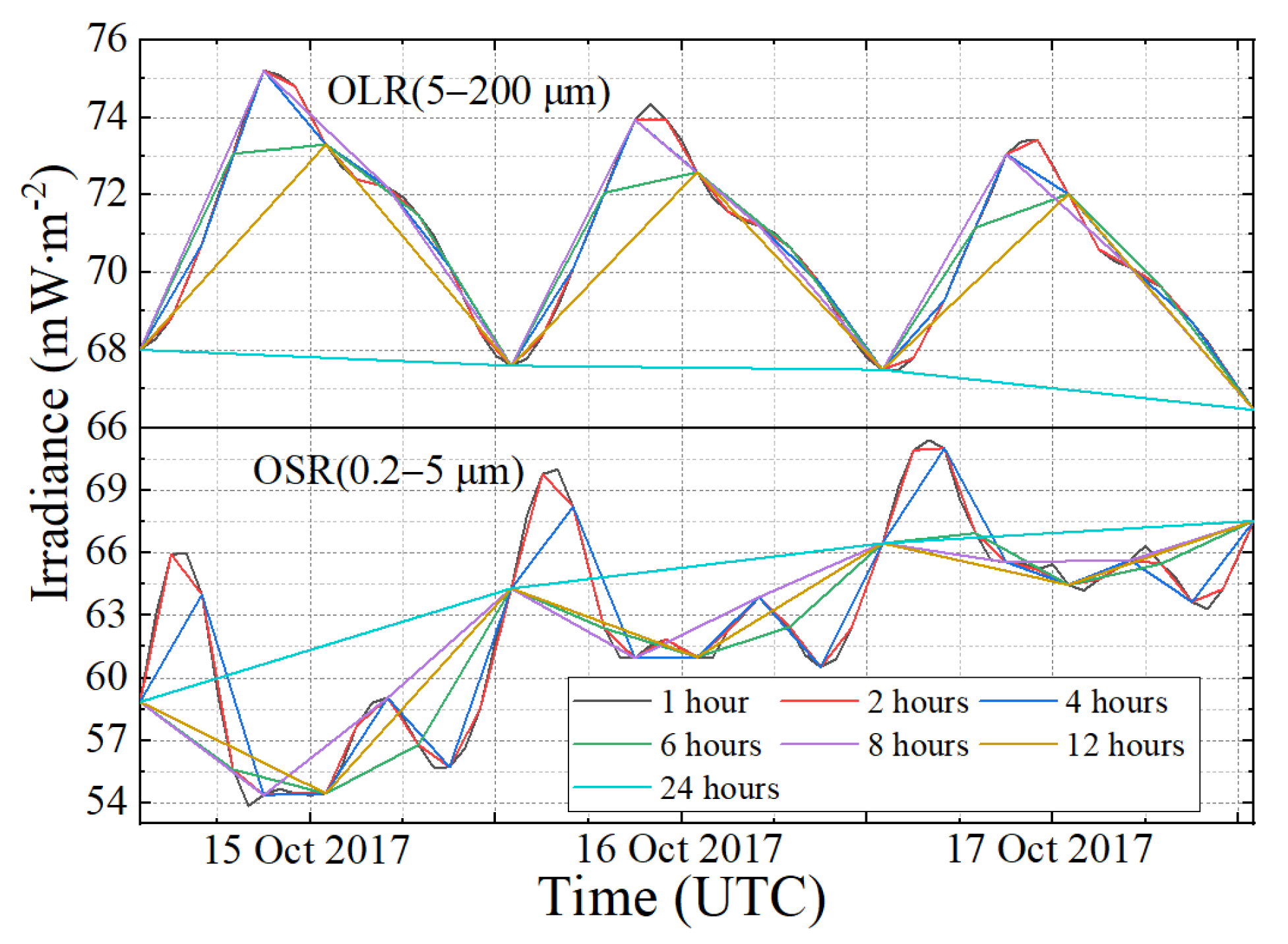


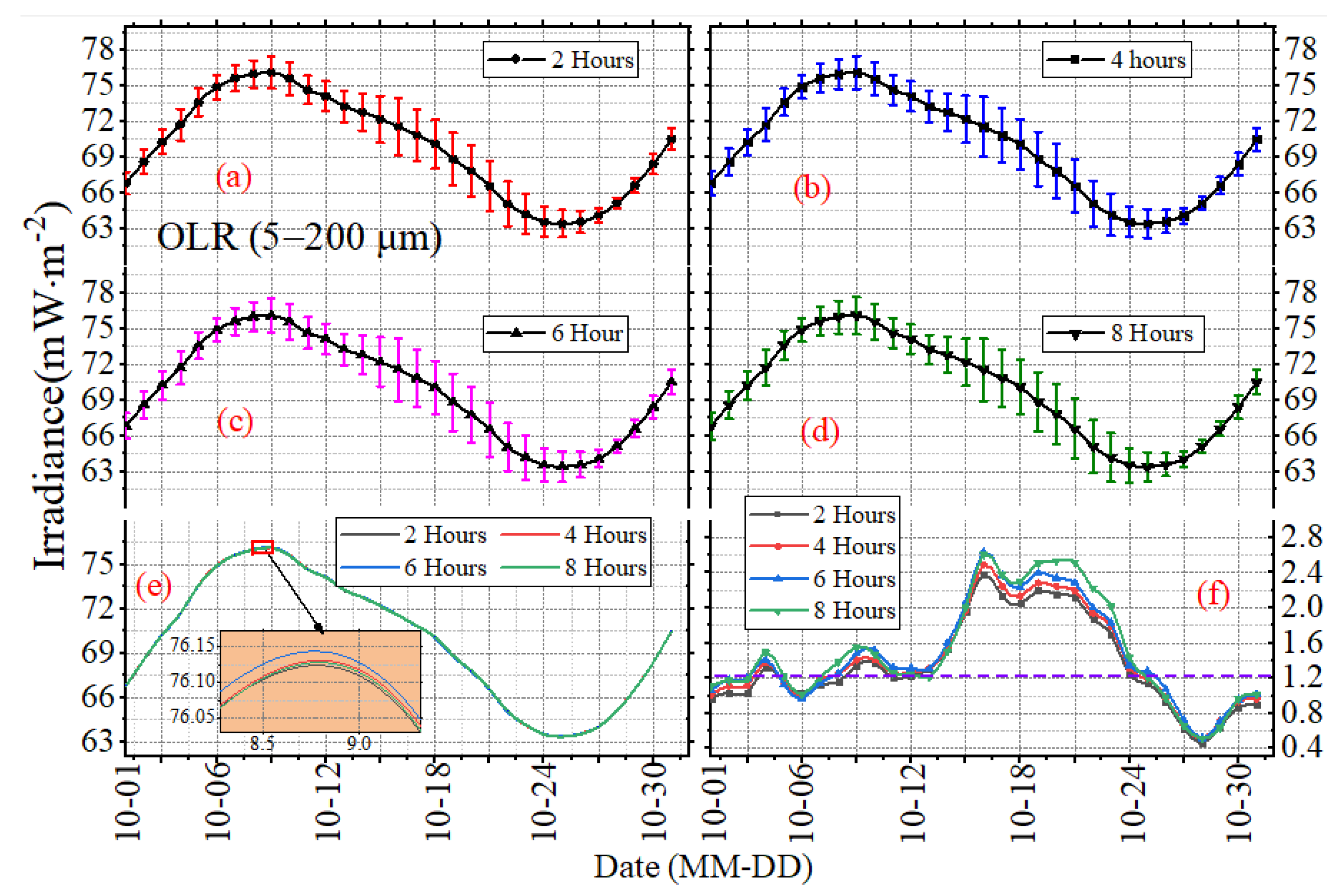
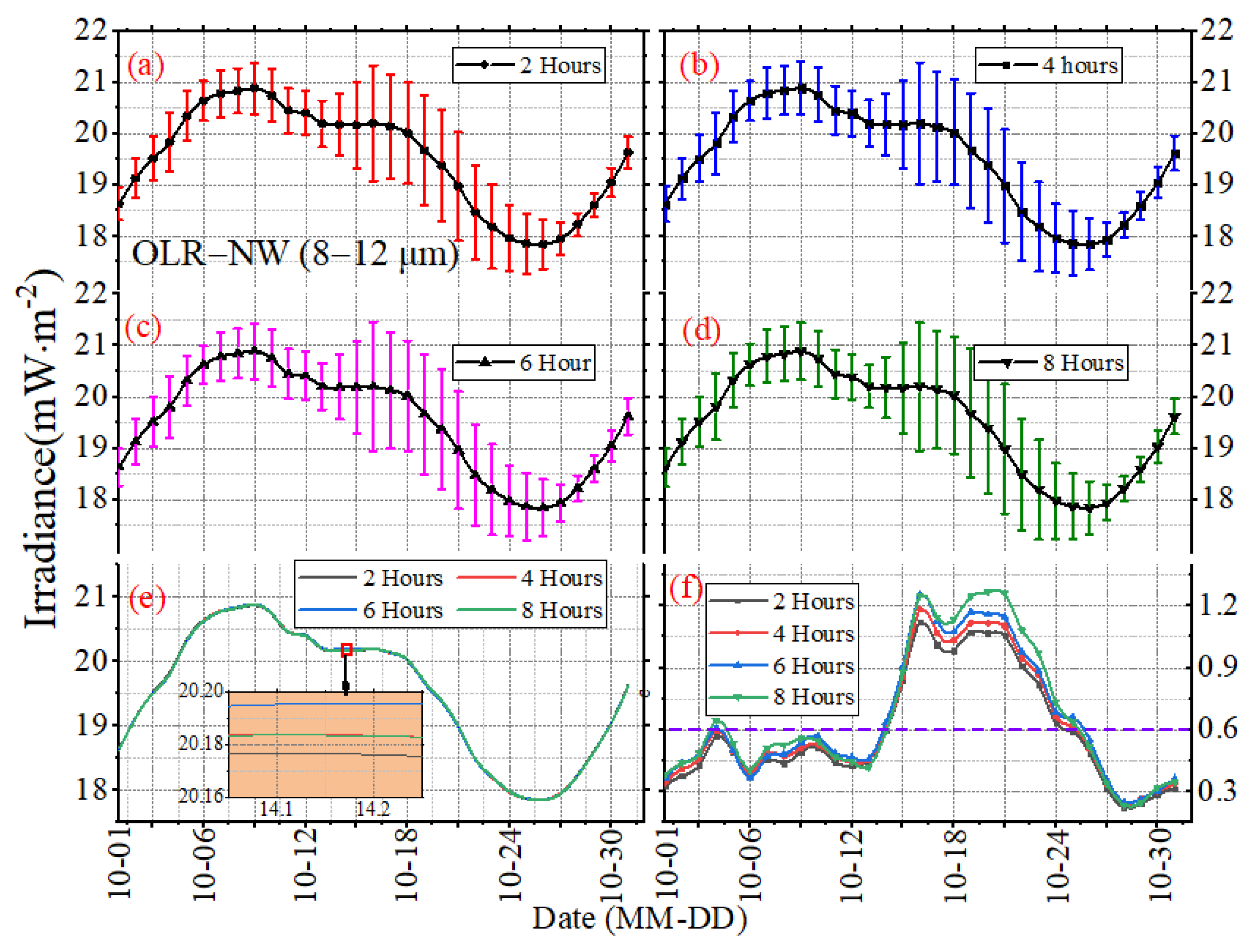
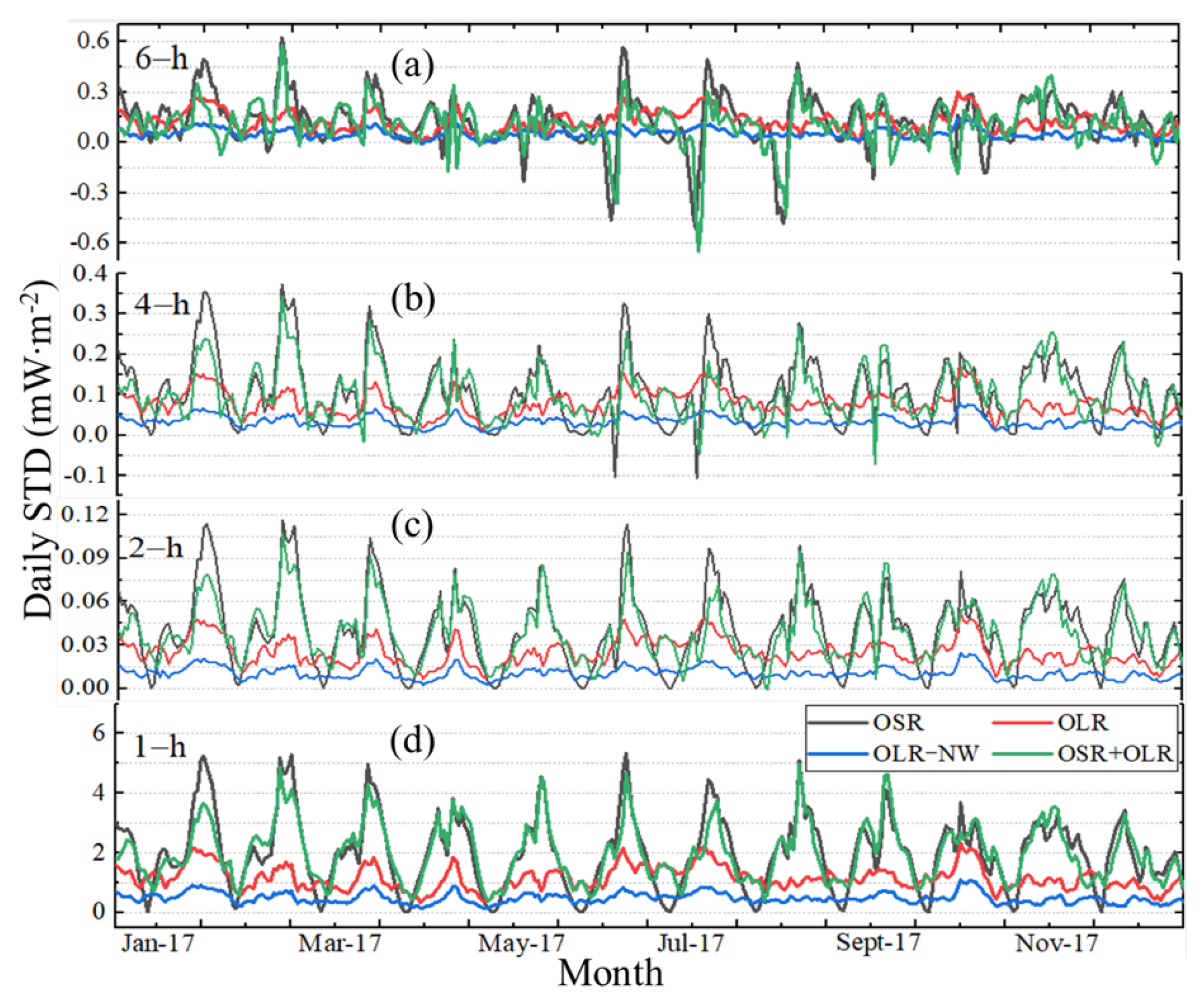
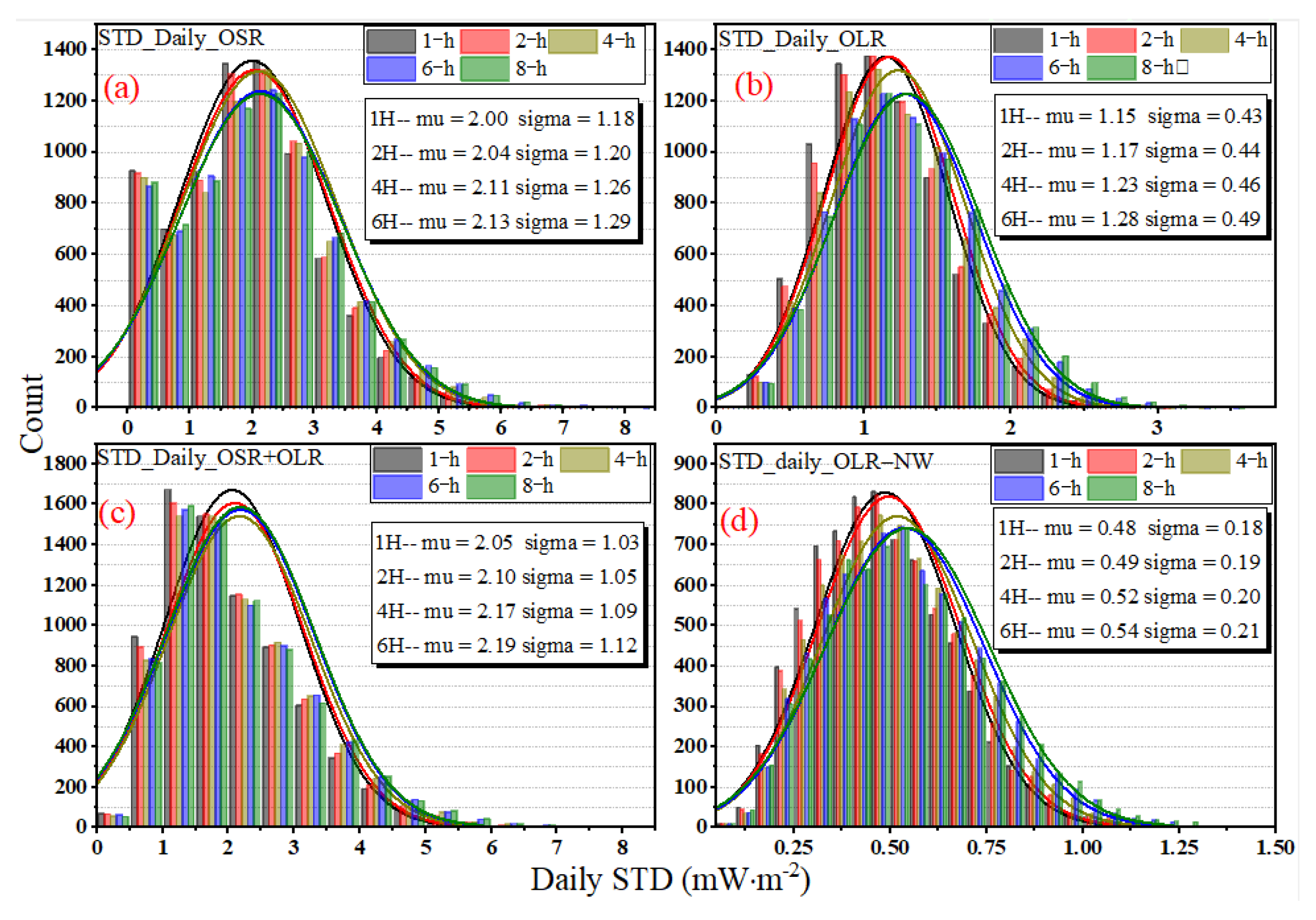

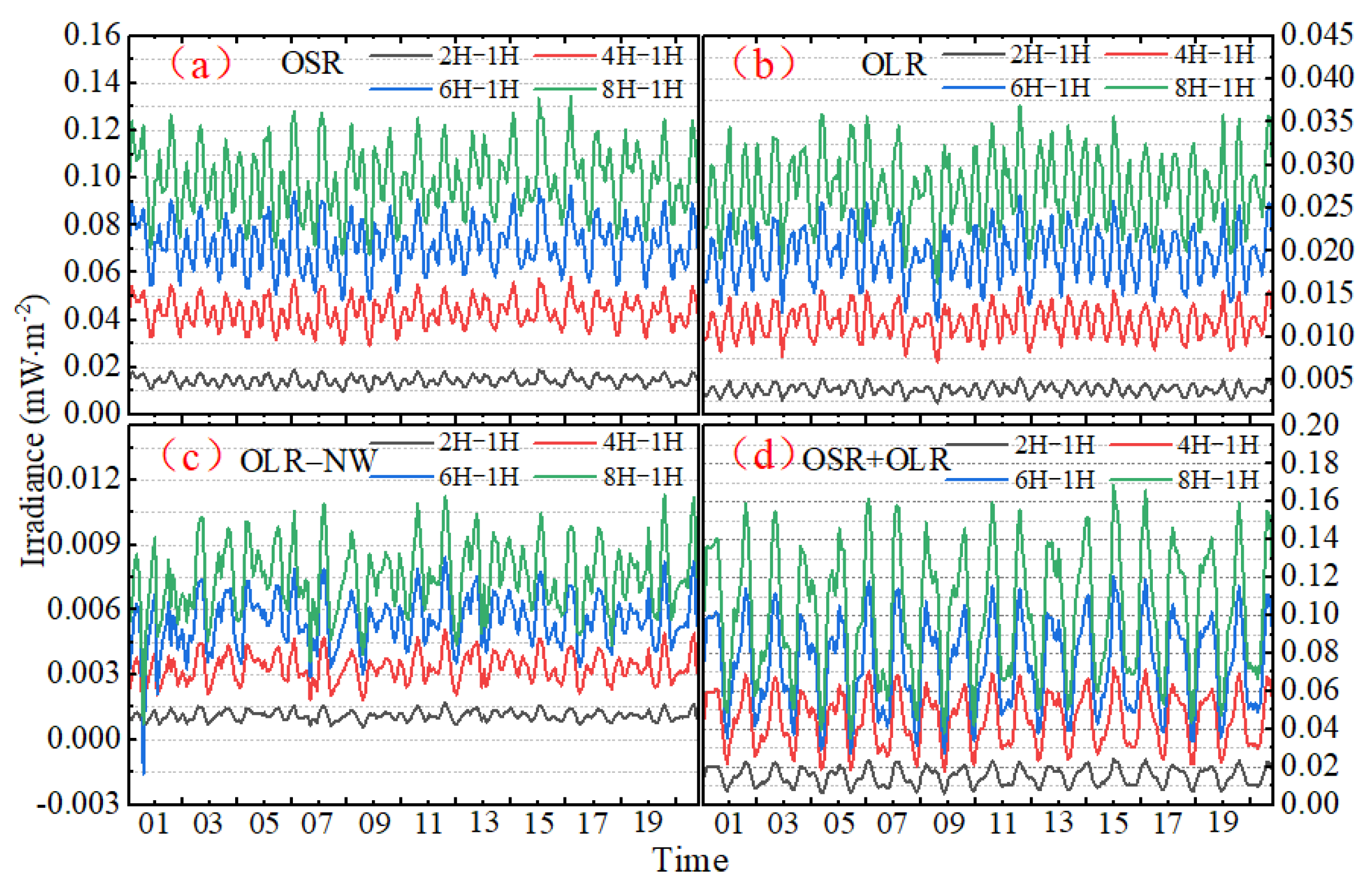




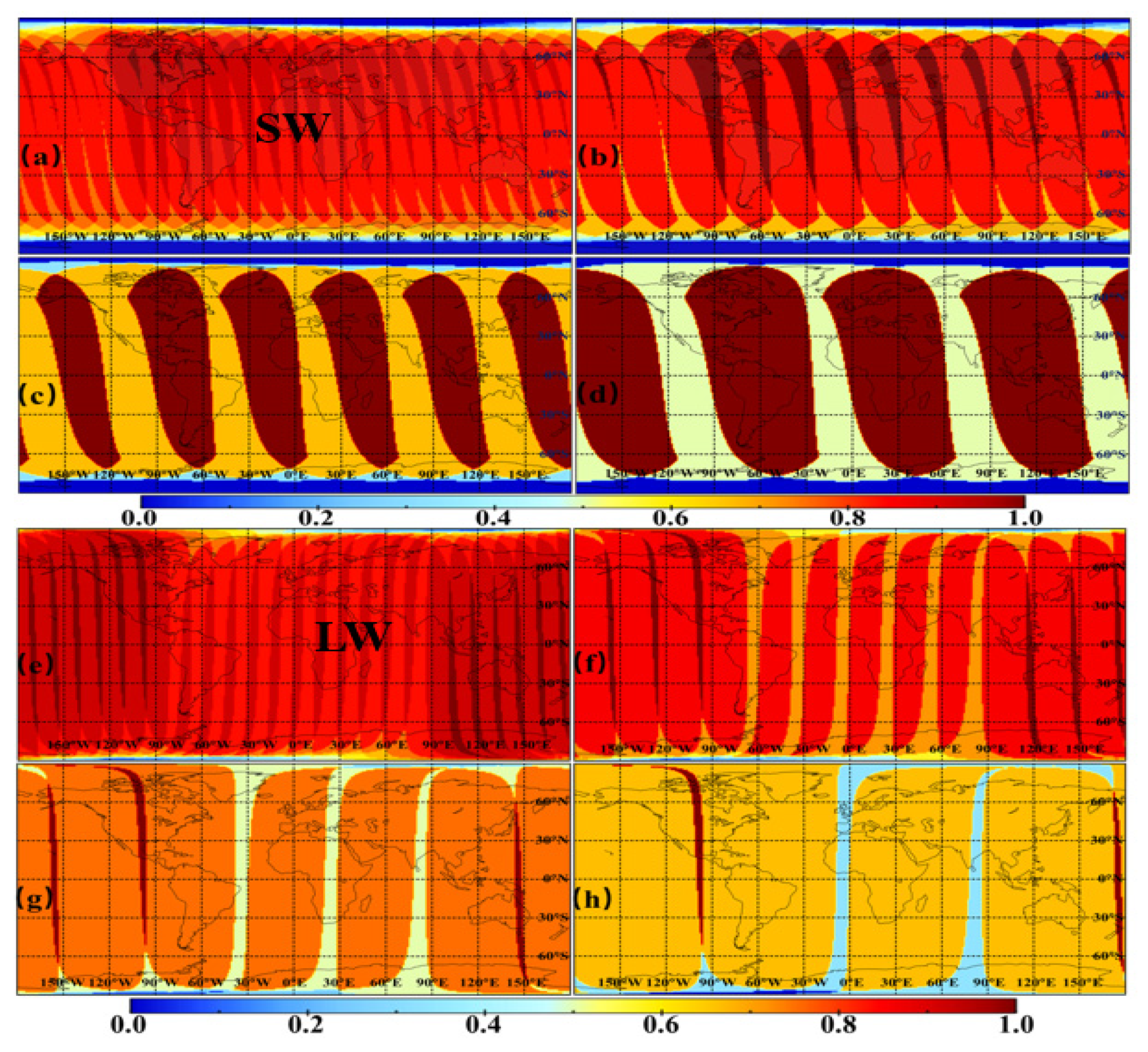
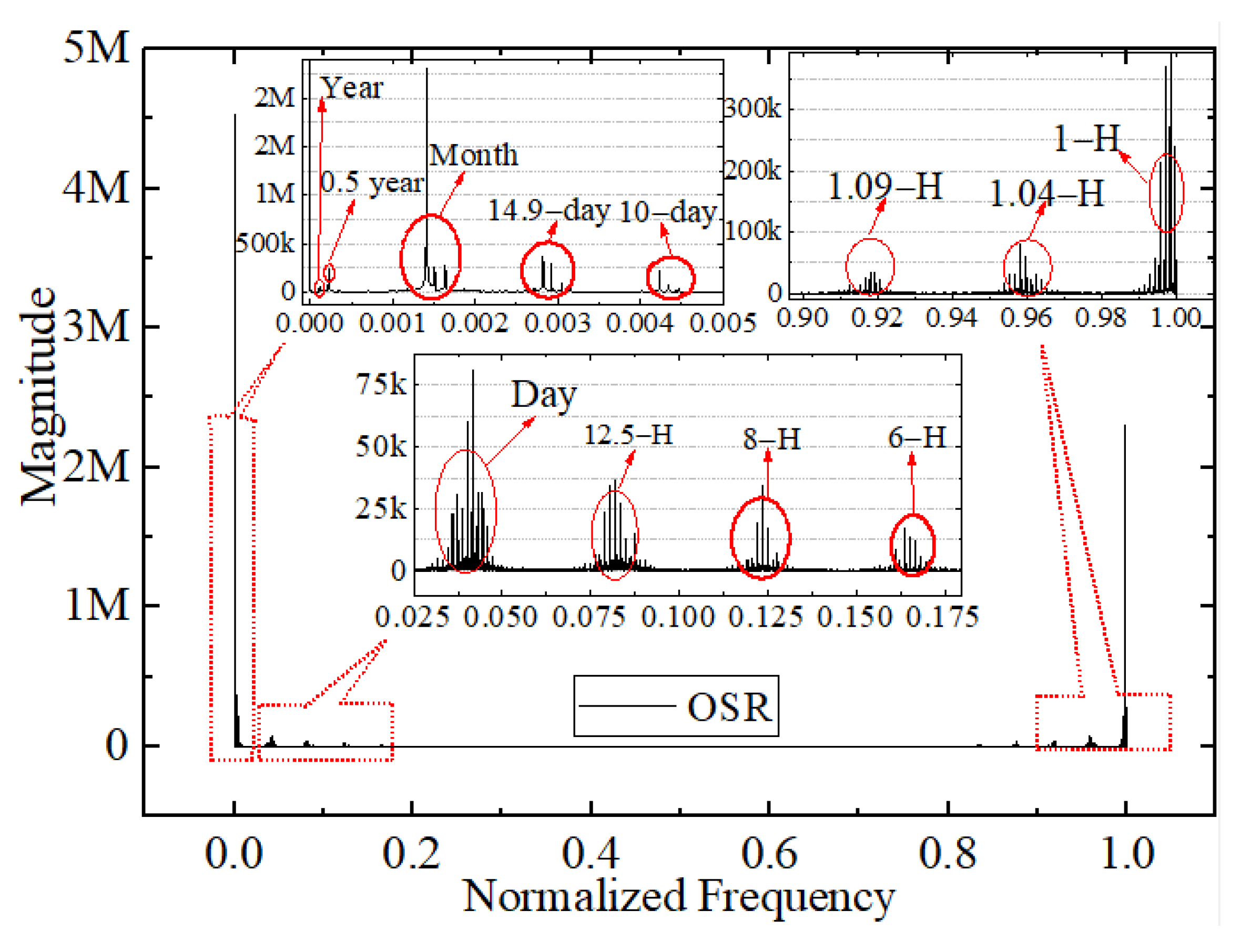
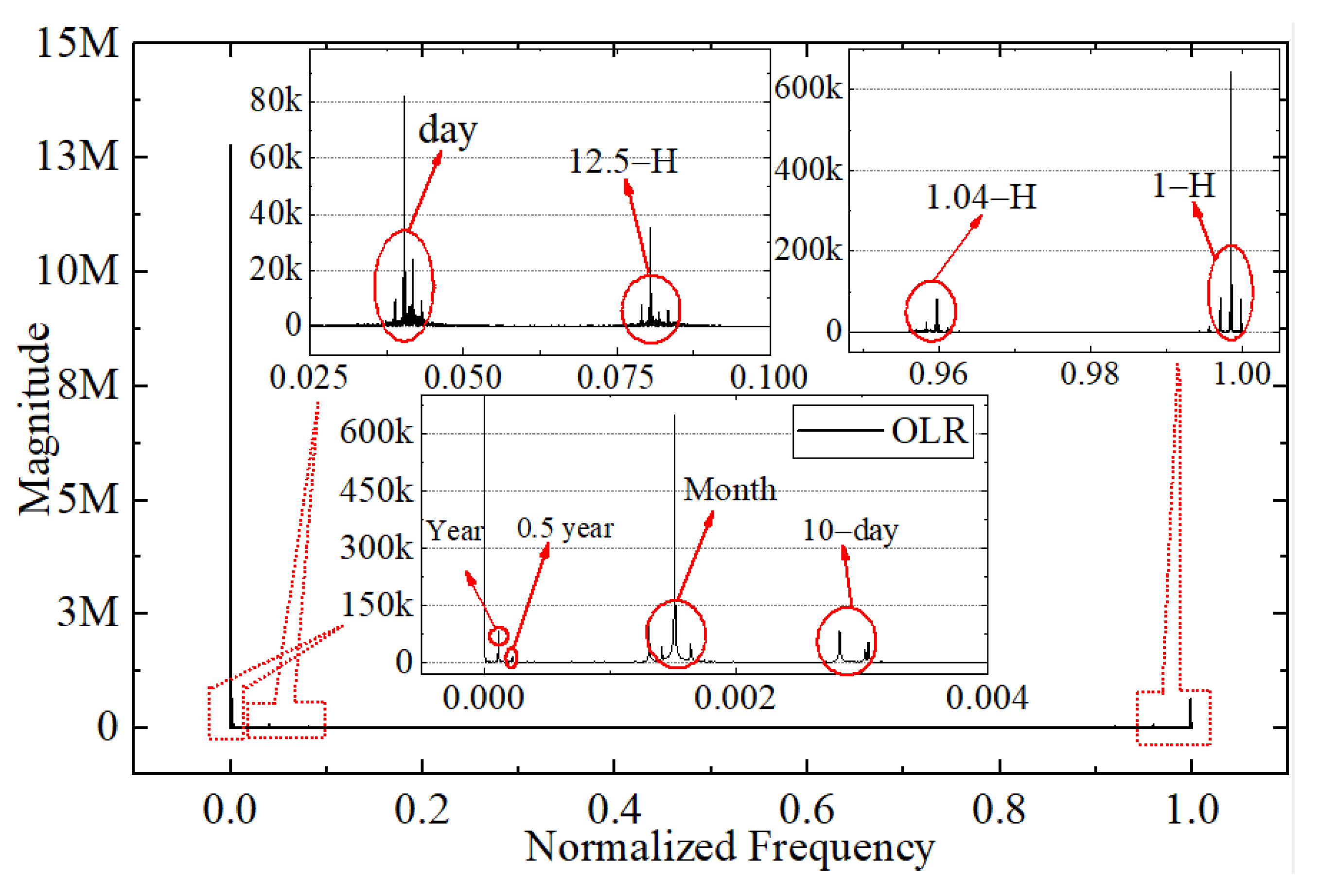
| Scene Type Bin | Scene | Cloud Fraction Range |
|---|---|---|
| 1 | Clear Ocean | 0.00−0.05 |
| 2 | Clear Land | 0.00−0.05 |
| 3 | Clear Snow | 0.00−0.05 |
| 4 | Clear Desert | 0.00−0.05 |
| 5 | Clear Land–Ocean Mix (Coastal) | 0.00−0.05 |
| 6 | Partly Cloudy Over Ocean | 0.05−0.50 |
| 7 | Partly Cloudy Over Land or Desert | 0.05−0.50 |
| 8 | Partly Cloudy Over Land–Ocean Mix | 0.05−0.50 |
| 9 | Mostly Cloudy Over Ocean | 0.50−0.95 |
| 10 | Mostly Cloudy Over Land or Desert | 0.50−0.95 |
| 11 | Mostly Cloudy Over Land–Ocean Mix | 0.50−0.95 |
| 12 | Overcast | 0.95−1.00 |
| OSR | OLR | OLR-NW | OSR + OLR | ||
|---|---|---|---|---|---|
| Monthly | Mean | 20.54~31.45 | 67.59~72.24 | 18.45~20.34 | 89.75~101.53 |
| STD | 14.46~27.95 | 3.40~7.63 | 0.90~2.53 | 8.57~34.93 | |
| Annual | Mean | 24.10~26.03 | 69.4~70.23 | 19.25~19.63 | 93.61~95.93 |
| STD | 20.47~23.06 | 5.46~6.15 | 1.65~1.86 | 21.03~26.08 | |
| Interval | Start Time | ||||||||
|---|---|---|---|---|---|---|---|---|---|
| 1 | 2 | 3 | 4 | 5 | 6 | 7 | 8 | ||
| OSR | 2 h | 1 | 1 | × | × | × | × | × | × |
| 4 h | 0.9999 | 0.9999 | 0.9999 | 0.9999 | × | × | × | × | |
| 6 h | 0.9994 | 0.9997 | 0.9999 | 0.9998 | 0.9997 | 0.9997 | × | × | |
| 8 h | 0.9996 | 0.9996 | 0.9997 | 0.9996 | 0.9996 | 0.9996 | 0.9990 | 0.9986 | |
| OLR | 2 h | 1 | 1 | × | × | × | × | × | × |
| 4 h | 0.9998 | 0.9999 | 0.9999 | 0.9999 | × | × | × | × | |
| 6 h | 0.9995 | 0.9997 | 0.9999 | 0.9999 | 0.9997 | 0.9995 | × | × | |
| 8 h | 0.9992 | 0.9995 | 0.9998 | 0.9998 | 0.9998 | 0.9997 | 0.9991 | 0.9992 | |
| OLR − NW | 2 h | 1 | 1 | × | × | × | × | × | × |
| 4 h | 0.9998 | 0.9998 | 0.9999 | 0.9997 | × | × | × | × | |
| 6 h | 0.9992 | 0.9992 | 0.9993 | 0.9995 | 0.9992 | 0.9992 | × | × | |
| 8 h | 0.9996 | 0.9990 | 0.9993 | 0.9990 | 0.9986 | 0.9986 | 0.9988 | 0.9986 | |
| OLR + OSR | 2 h | 1 | 1 | × | × | × | × | × | × |
| 4 h | 0.9999 | 0.9999 | 0.9999 | 0.9999 | × | × | × | × | |
| 6 h | 0.9994 | 0.9995 | 0.9999 | 0.9998 | 0.9996 | 0.9997 | × | × | |
| 8 h | 0.9996 | 0.9996 | 0.9998 | 0.9997 | 0.9996 | 0.9996 | 0.9989 | 0.9987 | |
| Times | 1 | 2 | 3 | 4 | 5 | 6 | 7 | 8 | ≥9 | |
|---|---|---|---|---|---|---|---|---|---|---|
| SW | 1 h | 0.39% | 0.32% | 0.48% | 0.69% | 1.03% | 1.45% | 2.2% | 3.51% | 82.28% |
| 2 h | 0.76% | 1.46% | 3.08% | 9.27% | 65.17% | 12.37% | 0 | 0 | 0 | |
| 4 h | 3.42% | 44.00% | 44.22% | 0 | 0 | 0 | 0 | 0 | 0 | |
| 6 h | 33.08% | 57.82% | 0 | 0 | 0 | 0 | 0 | 0 | 0 | |
| LW | 1 h | 0.07% | 0.09% | 0.11% | 0.29% | 0.40% | 0.41% | 0.44 | 0.66% | 97.52% |
| 2 h | 0.18% | 0.57% | 0.83% | 1.58% | 19.27% | 72.78% | 4.76% | 0 | ||
| 4 h | 1.09% | 11.51% | 84.84% | 2.42% | 0 | 0 | 0 | 0 | ||
| 6 h | 8.51% | 89.38% | 1.66% | 0 | 0 | 0 | 0 | 0 | ||
Publisher’s Note: MDPI stays neutral with regard to jurisdictional claims in published maps and institutional affiliations. |
© 2022 by the authors. Licensee MDPI, Basel, Switzerland. This article is an open access article distributed under the terms and conditions of the Creative Commons Attribution (CC BY) license (https://creativecommons.org/licenses/by/4.0/).
Share and Cite
Zhang, Y.; Bi, S.; Wu, J. Effect of Temporal Sampling Interval on the Irradiance for Moon-Based Wide Field-of-View Radiometer. Sensors 2022, 22, 1581. https://doi.org/10.3390/s22041581
Zhang Y, Bi S, Wu J. Effect of Temporal Sampling Interval on the Irradiance for Moon-Based Wide Field-of-View Radiometer. Sensors. 2022; 22(4):1581. https://doi.org/10.3390/s22041581
Chicago/Turabian StyleZhang, Yuan, Shengshan Bi, and Jiangtao Wu. 2022. "Effect of Temporal Sampling Interval on the Irradiance for Moon-Based Wide Field-of-View Radiometer" Sensors 22, no. 4: 1581. https://doi.org/10.3390/s22041581
APA StyleZhang, Y., Bi, S., & Wu, J. (2022). Effect of Temporal Sampling Interval on the Irradiance for Moon-Based Wide Field-of-View Radiometer. Sensors, 22(4), 1581. https://doi.org/10.3390/s22041581





